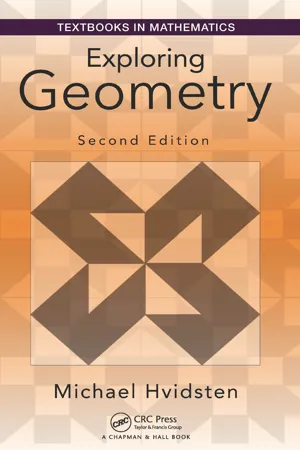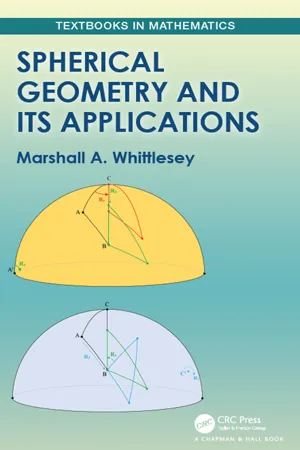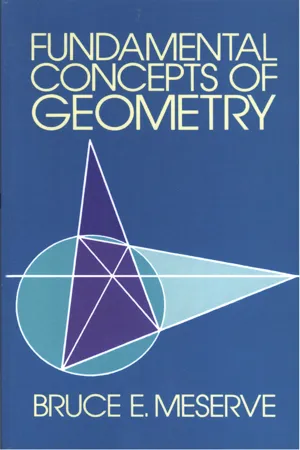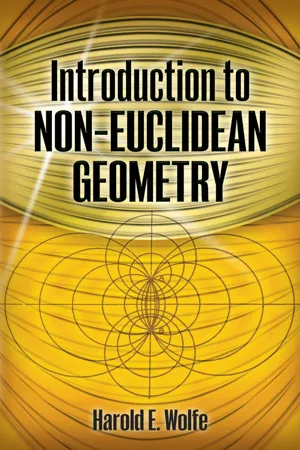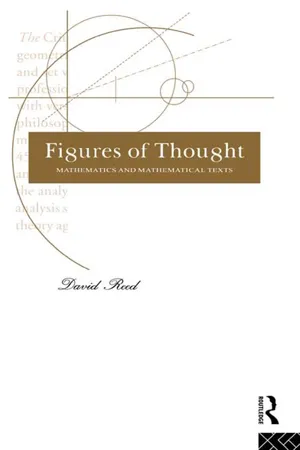Mathematics
Parallel Lines Theorem
The Parallel Lines Theorem states that if two parallel lines are cut by a transversal, then the corresponding angles are congruent, the alternate interior angles are congruent, and the consecutive interior angles are supplementary. This theorem is fundamental in understanding the properties of parallel lines and transversals in geometry.
Written by Perlego with AI-assistance
Related key terms
6 Key excerpts on "Parallel Lines Theorem"
- eBook - ePub
Yearning for the Impossible
The Surprising Truths of Mathematics, Second Edition
- John Stillwell(Author)
- 2018(Publication Date)
- CRC Press(Publisher)
Imagining Numbers , Penguin 2003, pp. 64 and 69One of the key concepts in geometry is that of parallel lines , which can be simply described as lines in the plane that do not meet. The purpose of this chapter is to explain why parallel lines are important, and to show that they become even more important when allowed to meet .’ This paradox—of allowing lines to meet when they don’t—will be explained in Section 3.3 . In the present section we set the stage by reviewing the basic properties of parallels and some of their consequences.First, parallels exist and they are unique. A precise statement of this property is the following:Parallel axiom.is any line and P is a point outside it , then there is exactly one line through P that does not meetI f LL .This unique line is called the parallel tothrough P (Figure 3.3 ).LIn calling the existence and uniqueness of parallels an “axiom” we are not suggesting there is any doubt about its truth. Rather, we are stressing its role as a startingpoint , from which other truths follow The role of parallel lines in geometry was first recognized by Euclid, who demonstrated in his Elements that many theorems of geometry follow from the existence and uniqueness of parallels.Figure 3.3: Parallel lines.Euclid did not state the parallel axiom as we have; in fact his version is much more cumbersome. The Greeks did not accept infinite lines, only the possibility of extending a finite line indefinitely, so Euclid had to state the parallel axiom as a condition under which finite lines do meet, if extended sufficiently far. His statement is equivalent to the parallel axiom above, but goes as follows.Euclid’s parallel axiom . If a line N , crossing linesandL, makes angles α and β with them on the same side with α + β less than two right angles , thenMandLmeet on this side if extended sufficiently far . (Figure 3.4M - eBook - ePub
- Michael Hvidsten(Author)
- 2016(Publication Date)
- Chapman and Hall/CRC(Publisher)
In the proof of this result found in the on-line chapter on Hilbert’s axioms, we note that the proof uses the idea of extending a segment along a line, which is the focus of Euclid’s second axiom. Geometers have often intuitively understood this axiom to imply that a line has infinite extent, or length. A careful reading of the second Euclidean axiom does not support this understanding.In fact, consider the “spherical” geometry introduced in Exercise 1.6.7 of Chapter 1 . Here we interpreted the term point to mean a point on a sphere and a line to be a part of a great circle on the sphere. In this geometry segments can always be extended (you can always move around the great circle, even though you may re-trace your path), but lines are not infinite in extent.We will return to this question of the boundedness of lines in Chapter 8 , where we develop a non-Euclidean geometry akin to that of the sphere.Theorem 2.7 .(Prop. 27 of Book I) If a line n falling on two lines l and m makes the alternate interior angles congruent to one another, then the two lines l and m must be parallel (Figure 2.5 ).Figure 2.5 Alternate interior anglesTheorem 2.8 .(Prop. 28 of Book I) If a line n falling on two lines l and m makes corresponding angles congruent, or if the sum of the measures of the interior angles on the same side equal two right angles, then l and m are parallel (Figure 2.6 ).Figure 2.6 Angles and parallelsWe note here that all of the preceding theorems are independent of the fifth Euclidean postulate, the parallel postulate. That is, they can be proved from an axiom set that does not include the fifth postulate. Such results form the basis of what is called absolute or neutral geometry. All of the theorems and results found in the on-line chapter on Hilbert’s axioms, except the section on Euclidean Geometry, are independent of the parallel postulate and thus form the basis for neutral geometry.The first time that Euclid actually used the fifth postulate in a proof was for Proposition 29 of Book I. Recall that the fifth postulate states: - eBook - ePub
- Marshall Whittlesey(Author)
- 2019(Publication Date)
- Chapman and Hall/CRC(Publisher)
↔ .The (Euclidean) parallel postulate states that given a line and a point not on the line, there exists a unique line through the given point parallel to the given line.The parallel postulate has a long and important history in geometry. Euclid took a similar statement as a basic proposition not to be proven, but many mathematicians in the millennia after him thought it important (and non-obvious) enough that it ought to be proven from other more basic propositions in plane geometry. In the nineteenth century it turned out that the uniqueness assertion in the parallel postulate above cannot be proven from other more generally accepted postulates in plane geometry. The basic reason is that there are other two-dimensional surfaces with natural notions of “point” and “line” satisfying all the accepted postulates about points and lines in the plane, except for the parallel postulate. The sphere will turn out to be a surface without parallelism.Suppose that A, B, and C are three points which do not lie on a single line. Then the union of the three segments, and,A B¯B C¯constitutes the triangle ΔABC. Each of the three points is said to be a vertex (plural: vertices) of the triangle, the three segments are the sides of the triangle, and the angles ∠ABC, ∠ACB, and ∠BAC are the (interior) angles of the triangle. If one of the angles of a triangle is in a linear pair with a second angle, the second angle is said to be an exterior angle of the triangle.A C¯If one of the angles of the triangle is a right angle, then the triangle is said to be a right triangle. The side opposite the right angle is called the hypotenuse and the other sides are called legs. If two sides of a triangle are congruent then the triangle is isosceles - eBook - ePub
- Bruce E. Meserve(Author)
- 2014(Publication Date)
- Dover Publications(Publisher)
Consider two distinct parallel lines m and m′ and a transversal t (i.e., a line that is not parallel to m). Define corresponding angles, alternate interior angles, and alternate exterior angles. 9. Prove that when parallel lines are cut by a transversal, any two corresponding angles are equal, alternate interior angles are equal, and alternate exterior angles are equal. 10. Prove that if the sides of one angle are parallel to the sides of another angle, then the angles are equal or supplementary. 11. Prove that two angles are equal if they are (a) supplementary to the same or equal angles, (b) complementary to the same or equal angles. 12. Given a point O on a plane, use the measures of angles with vertex O to obtain a distance relationship on the ideal line. 13. Is the distance function obtained in Exercise 12 a euclidean distance function? Explain. 14. Prove that in euclidean geometry any angle ACB where AB is a diameter of a circle and C is a third point on that circle (i.e., any angle inscribed in a semicircle) is a right angle. 15. Use the property obtained in Exercise 13 and give another definition of a circle. 6–8 Common figures. We have developed euclidean plane geometry from the undefined terms (point and line), the undefined relations of incidence and separation, and the postulates of incidence, existence, projectivity, harmonic sets, separation, and continuity (based upon the isomorphism between the set of real numbers and the set of real points on a line). This synthetic development has been proved to be equivalent to an algebraic (or analytic) development in terms of triples of real numbers, the properties of numbers, and the properties of algebra. The euclidean plane has been defined by considering only real points on a projective plane with one line deleted - eBook - ePub
- Harold E. Wolfe(Author)
- 2013(Publication Date)
- Dover Publications(Publisher)
Consider two parallel lines and a transversal. The two extensions of the lines on one side of the transversal are no more parallel than their two extensions on the other side of it. Then, if the sum of the two interior angles on one side is greater than two right angles, so also is the sum of those on the other. But this is impossible, since the sum of the four angles is equal to four right angles. In a similar way it can be argued that the sum of the interior angles on one side cannot be less than two right angles. The conclusion is obvious.19. Proclus.Proclus himself pointed out the fallacy in the above argument by remarking that Ptolemy really assumed that through a point only one parallel can be drawn to a given line. But this is equivalent to assuming the Fifth Postulate.Proclus submitted a proof of his own. He attempted to prove that if a straight line cuts one of two parallel lines it will cut the other also. We already know that the Fifth Postulate follows readily from this. He proceeded thus:Figure 9Given two parallel lines AB and CD (Fig. 9 ) with the straight line EF cutting AB at E. Assume that a point P moves along EF in the direction of F. Then the length of the perpendicular from P to AB eventually becomes greater than any length and hence greater than the distance between the parallels. Hence EF must cut CD.The fallacy lies in the assumption that parallels are everywhere equally distant or at any rate that parallels are so related that, upon being produced indefinitely, the perpendicular from a point on one to the other remains of finite length. The former implies the Fifth Postulate, as has already been proved; the latter does also, as we shall see later.1020. Nasiraddin.For our next example we pass to the thirteenth century and consider the contributions of Nasiraddin (1201-1274), Persian astronomer and mathematician, who compiled an Arabic version of Euclid and wrote a treatise on the Euclidean postulates. He seems to have been the first to direct attention to the importance, in the study of the Fifth Postulate, of the theorem on the sum of the angles of a triangle. In his attempt to prove the Postulate one finds the germs of important ideas which were to be developed later. - eBook - ePub
Figures of Thought
Mathematics and Mathematical Texts
- David Reed(Author)
- 2003(Publication Date)
- Routledge(Publisher)
Postulate 4 has attracted the least attention from commentators but provides in fact the clearest example of Euclid's method. Right angles are defined in Definition 10 as equal adjacent angles produced when one straight line is set upon another. The definition itself is insufficient to rule out the possibility that different sets of right angles might not be equal to one another. In such a case additional ‘external’ specifications or determinations would be required to distinguish and relate the various sets of ‘right angles’. Postulate 4 removes such a possibility by making the elements of their definition sufficient for the determination of right angles.Postulates 1–4 cover points, lines, angles and circles, thus only surfaces, rectilinear figures and parallel lines remain to be addressed. Postulate 5 deals with all of these. Recall that the definition of parallel lines was phrased in the negative; this definition is a peculiar type of limit as it defines something which is not delimited. Postulate 5 is therefore not about parallel lines as such in that it does not provide a sufficient condition for lines to be parallel in the way in which Postulates 1–4 provide determinations of straight lines, angles and circles. Instead Postulate 5 provides a determination of non-parallel lines (and therefore, implicitly, of triangles). This Postulate depends on Postulate 2 (to be able to extend the lines) and Postulate 4 (providing right angles as a stable measure). The further determination that Postulate 5 provides is that the non-parallelism of the lines as extended is dependent only on the angles formed by the transverse line. That these angles are measured against right angles is due to the fact that right angles are the only stable measures available. Additional ‘external’ determinations would be required if the standards of measurement chosen were not right angles.From this point of view, Postulate 5 is not a selection of a ‘type’ of geometry (one among many), an attempt to prescribe spatial intuition as fundamental or even a ‘self-evident’ truth. This Postulate, like the others, provides a kind of self-determination within the material given by the definitions so that the parts necessary to define a given element also suffice to determine it. More particularly, without Postulate 5, data would be required to specify the relationships between lines and angles in figures apart from the lines and angles themselves. The long history of commentary and analysis of this Postulate, by treating it as a proposition instead of a postulate (one of the natural consequences of the usual understanding of ‘axiomatization’ as will be seen when Hilbert's geometry is discussed) has overlooked this simple functioning of Postulate 5 within the argument of the Elements
Index pages curate the most relevant extracts from our library of academic textbooks. They’ve been created using an in-house natural language model (NLM), each adding context and meaning to key research topics.

